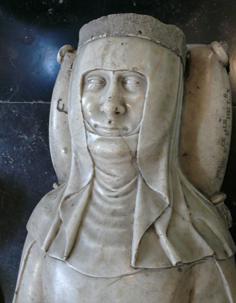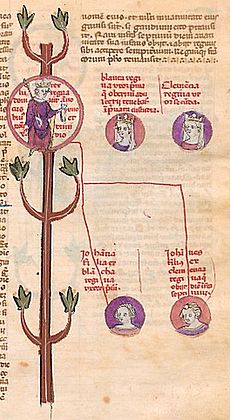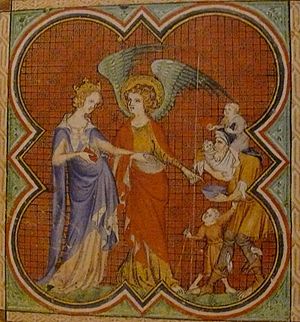Joan II of Navarre facts for kids
Quick facts for kids Joan II |
|
|---|---|

Bust in the Louvre, originally from the Jacobin convent which housed Joan's heart
|
|
| Queen of Navarre with Philip III (1328-1343) |
|
| Reign | 1 April 1328 – 6 October 1349 |
| Coronation | 5 March 1329 (Pamplona) |
| Predecessor | Charles I |
| Successor | Charles II |
| Born | 28 January 1312 |
| Died | 6 October 1349 (aged 37) Navarre |
| Spouse | Philip III, King of Navarre |
| Issue | |
| House | Capet |
| Father | Louis X of France (Louis I of Navarre) |
| Mother | Margaret of Burgundy |
Joan II (French: Jeanne; 28 January 1312 – 6 October 1349) was the Queen of Navarre from 1328 until her death. She was the only surviving child of Louis X of France, who was King of France and Navarre, and Margaret of Burgundy. There were some questions about Joan's true father because her mother was involved in a scandal. However, Louis X said Joan was his rightful daughter before he died in 1316.
Even so, French nobles did not want a female ruler. They chose Louis X's brother, Philip V, to be king instead. The Navarrese nobles also supported Philip. Joan's grandmother and uncle tried to get her the counties of Champagne and Brie. These lands had belonged to Louis X's mother, Joan I of Navarre. But French royal troops defeated Joan's supporters. Philip V later married his daughter to Joan's uncle and gave him two counties as a wedding gift. In return, Joan's uncle gave up her claim to Champagne and Brie in March 1318. Joan then married Philip of Évreux, who was also part of the French royal family.
Philip V was followed by his brother, Charles IV, as king of both France and Navarre in 1322. But most Navarrese lords refused to promise loyalty to Charles. When Charles IV died in 1328, the people of Navarre removed the French governor. They declared Joan their rightful queen. In France, Philip of Valois became king. He made a deal with Joan and her husband. They gave up Joan's claims to Champagne and Brie. In exchange, they received three other counties. Philip also agreed that Joan and Philip had the right to rule Navarre. Joan and her husband were crowned together in Pamplona Cathedral on 5 March 1329.
The royal couple worked closely together during their time as rulers. Philip of Évreux was often more active in governing. However, they mostly lived in their French lands. Navarre was managed by governors when they were away.
Contents
Becoming Queen: Joan's Claim to the Throne
Early Life and Family
Joan was born in 1312. Her father was Louis, King of Navarre. Her mother was Margaret of Burgundy. Joan's father was the oldest son of King Philip IV of France and Queen Joan I of Navarre.
Doubts About Joan's Birth
In 1314, Joan's mother, Margaret, and two other royal women were arrested. This event made people question if Joan was truly the daughter of King Louis.
King Philip IV died on 26 November 1314. Joan's father became Louis X of France. Margaret was technically Queen of France, but she stayed in prison. She died there not long after.
Before he died on 5 June 1316, Louis said that Joan was his legal daughter. His second wife, Clementia of Hungary, was pregnant. French lords made an agreement on 16 July. If Clementia had a son, he would be crowned King of France. If she had a daughter, that daughter and Joan could only inherit Navarre, Champagne, and Brie. These were lands Louis X had inherited from his mother. It was also agreed that Joan would go live with her mother's family in Burgundy. Her marriage could only be decided with the royal family's approval.
A Young Orphan's Struggles
Clementia gave birth to a son, John the Posthumous, on 13 November 1316. But he died just five days later. Joan's uncle, Odo IV, Duke of Burgundy, tried to protect Joan's rights. He talked with Philip IV's second son, Philip the Tall. But Philip did not agree to Odo's requests. Instead, Philip arranged his own coronation. It happened in Reims on 9 January 1317.
An assembly of French lords met on 2 February. They said that a woman could not inherit the French crown. This made Philip's claim stronger. Navarrese nobles also sent people to Paris to promise loyalty to Philip. Philip also refused to give Champagne and Brie to Joan.
Joan's grandmother protested Philip V's coronation. But Philip V became king without much opposition. Letters were sent in Joan's name to the lords of Champagne. They asked them not to support Philip and to protect Joan's rights. Odo IV argued that taking Joan's inheritance went against "divine law" and long-standing custom. However, Philip V's uncle defeated Joan's supporters.
Philip and Odo made a deal on 27 March 1318. Philip gave his oldest daughter, also named Joan, in marriage to Odo. They would inherit the counties of Burgundy and Artois. Joan was to marry her cousin, Philip of Évreux. She would receive money and the right to inherit Champagne and Brie if Philip V had no sons. They also agreed that Joan would give up her claims to France and Navarre when she turned twelve. There is no proof that she ever did this. Joan and Philip married on 18 June 1318. Joan then lived with her husband's grandmother.
The End of a Royal Line
Philip V died in early 1322 without a son. His brother, Charles the Fair, was Philip IV's last surviving son. Charles became king of both France and Navarre. Most Navarrese people refused to promise loyalty to Charles. He also did not confirm their special rights, called Fueros.
Charles died on 1 February 1328. This caused another problem with who would be the next ruler. Charles's wife was pregnant. French nobles met in Paris to choose a temporary ruler, called a regent. Most French lords decided that Philip of Valois had the strongest claim. He was the closest male relative to the dead king. In Navarre, representatives met on 13 March. They replaced the French governor with two local lords.
Charles's wife gave birth to a daughter on 1 April. This meant that the direct male line of the French royal family had ended. Joan and her husband could claim the French throne. They were both related to French kings. But there were at least five other people who also claimed the throne.
The Navarrese assembly passed a rule in May. They asked Joan to visit Navarre and take control. They said the crown belonged to her "by right of succession and inheritance."
Philip of Valois was crowned king of France in Reims on 29 May. He had no claim to Navarre, Champagne, or Brie. He was not related to Joan I of Navarre. To make his position stronger in France, Philip agreed in July that Joan and her husband had the right to rule Navarre. He also convinced them to give up Champagne and Brie. In exchange, they received the counties of Longueville, Mortain, and Angouleme. Philip wanted to keep Champagne and Brie for France because they were important.
Becoming King and Queen
After the Navarrese assembly's decision in May 1328, Joan was seen as the rightful ruler of Navarre. This decision ended the personal union of Navarre and France. This union had started when Joan I of Navarre married Philip IV of France.
For several months, Joan and her husband talked with the Navarrese leaders. They discussed Philip of Évreux's role in governing the kingdom. The Navarrese had only recognized Joan's right to rule. But her husband also claimed authority. While the couple was away, violent attacks against Jewish people happened in Navarrese towns.
Joan and Philip of Évreux sent two French lords to Navarre to represent them. The Navarrese were at first unsure about letting Philip share the queen's rule. In November 1328, delegates agreed that Philip could help govern Navarre. However, they said that traditional parts of the coronation would only be done for Joan. This included being lifted on a shield and throwing money to the crowd. To show Philip's right to rule, one of the lords said that "the head of woman is man." He also stressed that Joan had agreed to strengthen her husband's position.
Joan and Philip arrived in Navarre in early 1329. They were crowned in the Pamplona Cathedral on 5 March. Both were lifted on a shield and both threw money during the ceremony. They signed a coronation oath, which set out their royal powers. The document stated that Joan was the "true and natural heir" of Navarre. But it also said that "all of the kingdom of Navarre would obey her consort." The Navarrese also said that both Joan and Philip had to give up the crown when their heir turned twenty-one. If not, they would have to pay a large fine. Joan also paid her husband back for his costs related to gaining Navarre.
How They Ruled
Queen Joan II and King Philip III of Navarre worked very closely together. Out of 85 royal orders from their joint rule, 41 were issued in both their names. However, it seems Philip was more active in some areas of government, especially in making laws. He signed 38 orders by himself, without mentioning his wife. Only six documents were issued only in Joan's name.
After their coronation, the royal couple ordered that those who attacked Jewish people be punished. They also made sure the victims received money for their losses. Royal forts were repaired, and a new castle was built during their reign. They also helped pay for an irrigation system for dry fields.
Joan and Philip wanted to have good relationships with nearby countries. They began talking about marrying their oldest daughter, Joan, to the heir of Aragon in 1329. A peace treaty with Castille was signed on 15 March 1330.
Joan and Philip left Navarre in September 1331. Historians note that the royal couple had to manage their French lands as well as Navarre. This meant they had to divide their time. They found it hard to get used to the "tastes and customs of the Navarrese." They also did not speak the local language. Because of this, they were often away from the kingdom. French governors managed Navarre for them when they were gone.
A disagreement over a monastery led to a war with Castille in 1335. The King of Aragon supported the Navarrese. A new peace treaty with Castille was signed on 28 February 1336. Joan and Philip returned to Navarre in April 1336. Their second visit lasted until October 1337. Philip returned to Navarre twice more, but Joan did not go with him.
Philip III died in September 1343. Joan quickly replaced the governor of Navarre with a new one. She later replaced him again. These changes might show that she disagreed with Philip about how Navarre was run. In 1344, a copy of Navarre's special laws, the Fueros, was made for the queen. It was written in the local language, with space for a French translation. French was likely Joan's main language, even for Navarre's affairs. Joan founded a convent in Olite in 1345.
Joan planned to visit Navarre again, but she never returned. This was likely because of the risk of invasion in her French lands during the Hundred Years' War. She and her husband had supported the French king against the English king. By 1346, however, Joan was disappointed with the French king's military failures. In November, she made a truce with an English leader. This allowed English troops to pass through her land in exchange for protection. She also promised not to build new forts or let the French army use existing ones. The French king could not stop her.
Joan died from the Black Death on 6 October 1349. In her will, she asked her son to pay for a chapel in Santa Maria of Olite. She was buried in the Basilica of St Denis. Her heart was buried in Paris, alongside her husband's.
Joan's Family and Legacy
Joan's husband, Philip of Évreux, was the grandson of Philip III of France. They worked well together as rulers. There is no clear evidence about how close they were personally. But they were rarely apart and had nine children together.
- Joan (born around 1326–died 1387), was meant to marry the future King of Aragon, but she became a nun.
- Maria (born around 1329 – died 1347), was the first wife of Peter IV of Aragon.
- Louis (1330–1334)
- Blanche (1331–1398), was the second wife of Philip VI of France.
- Charles (1332–1387), became the next Count of Évreux and King of Navarre.
- Philip (born around 1333–died 1363), married Yolande de Dampierre.
- Agnes (1334–1396), married Gaston III, Count of Foix.
- Louis (1341–1372), Count of Beaumont-le-Roger, married twice.
- Joan (born after 1342–died 1403), married John I, Viscount of Rohan.
Royal Family Tree
See also
 In Spanish: Juana II de Navarra para niños
In Spanish: Juana II de Navarra para niños



